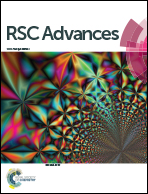Enhanced formaldehyde sensing properties of SnO2 nanorods coupled with Zn2SnO4†
Abstract
Ternary oxide Zn2SnO4 was introduced to a rod-like nanostructured SnO2 gas sensor for formaldehyde detection by a facile one-step hydrothermal synthesis. The effects of the Zn2SnO4 additive on the structure, morphology and gas-sensing property of SnO2 were investigated in this study. It was confirmed that control of the Zn amounts in the precursor solution was effective in realizing well-developed one- and two-dimensional coexisting structured SnO2–Zn2SnO4 (SnZn) nanocomposites. The gas sensing properties of the resulting SnZn composites to HCHO vapor were tested. The results showed that the presence of Zn2SnO4 species in SnO2 powders could effectively enhance electrical conductivity, reduce optimal operating temperature and improve the gas response of the sensors. The composite exhibited the highest response towards HCHO in the case of 35 at% Zn2SnO4 nanoplates coupling with hierarchical branched structures of SnO2 nanorods (SnZn35) at a relatively lower operating temperature of 162 °C. The good gas-sensing performance of the SnZn35 composite can be ascribed to the smaller particle size, the larger surface area and the more absorbed Ox− species, which all are favorable for gas diffusion and sensing reactions. This work renders great potential in the fabrication of gas sensors using a binary–ternary oxide composite, which can be further applied in indoor pollution detection.


 Please wait while we load your content...
Please wait while we load your content...